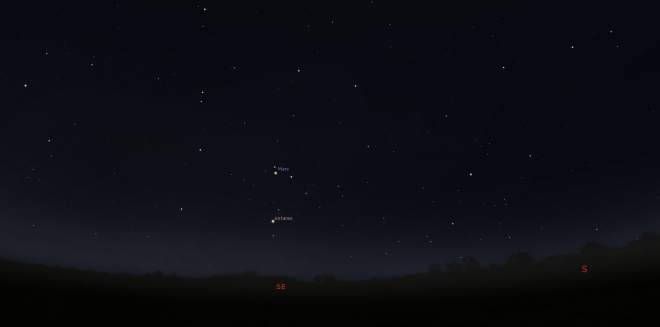What’s up in the pre-dawn sky?
January 10, 2020
By Amy Sayle
Do you get up while it’s still dark? Many of us do at this time of year, since sunrises are so late—nearly 7:30 a.m. in Chapel Hill.
Rather than grumbling at the short days, consider celebrating our long nights with some pre-dawn sky gazing. You’ll discover how the early morning sky differs from the early evening sky, as Earth’s rotation over the night brings different celestial delights into view.

If you wake up early to a clear sky, you can pop outside to:
- See the Red Planet and its rival. Mars will be visible to the southeast. Don’t confuse this reddish planet for the reddish star appearing below it, Antares, known as the rival of Mars. Expect to see Mars in the news this summer, when a good launch window opens for sending spacecraft there. Four missions by various space agencies are planned, including NASA’s Mars 2020 rover.
- Get a preview of spring. Spring beckons for those willing to get up early (or stay up really late). Leo the Lion, Virgo the Maiden, and other spring constellations are well placed in the pre-dawn winter sky. One particularly striking pattern is formed by the stars representing Leo’s head and mane. Play connect-the-dots in your mind to see a backward question mark of stars.
- Star hop with the Big Dipper. The Big Dipper currently lies high in the northern pre-dawn sky. See if you can spot the four stars that form the dipper’s bowl and the three stars that form the handle. Draw a line between the “pointer stars” at the side of the bowl (from the bottom of the bowl through the top) to guide you to Polaris, the North Star. Next, follow the curve of the Dipper’s handle to “arc” toward the bright orange star Arcturus. From there, “speed on to Spica,” another bright star.
- Wave hello to people in outer space. On several occasions over the next few days, the International Space Station (ISS) will make visible passes for North Carolina in the pre-dawn sky. Sign up for email or text alerts of when you can see it at NASA’s Spot the Station site. It’ll look like a bright white moving star. If you see it, wave hello to the six people on board. One of them is astronaut Christina Koch, who calls North Carolina her home and who recently set a new record for the longest single spaceflight by a woman.
To learn more about this winter’s sky (both evening and pre-dawn), join us this Saturday, January 11, 2020, at 3:30 p.m., for Star Families: Winter Skies. This 45-minute program under the planetarium sky is aimed at families with children ages 7-12. Or join us under the real sky (weather permitting) on Friday evening, February 28, 2020, for skywatching at Historic Stagville.

